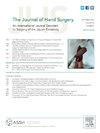嵌体与嵌体二头肌远端再植后旋前峰值:一项随机对照试验。
IF 2.1
2区 医学
Q2 ORTHOPEDICS
引用次数: 0
摘要
目的:远端肱二头肌肌腱(DBBT)断裂导致前臂旋后和屈曲运动时肘关节无力。手术治疗适用于功能要求高的年轻患者。本研究旨在评估两种不同的固定技术,缝合锚固定和双皮质钮扣嵌体固定手术修复后前臂旋后力量的恢复情况。方法:这是一项单中心、前瞻性、随机、对照研究。本研究共纳入40例DBBT完全性破裂患者,术前采用分组随机法将患者分为两组,一组接受嵌体固定(A组),另一组接受嵌体固定(B组)。两组均采用单切口前路入路。术前和术后至少6个月用数字测功仪测量前臂旋后肌力。双前臂旋后强度评估,测试肘关节在45°,90°和120°屈曲,前臂处于中性位置(0°)。结果:两组患者术后肌力峰值差异无统计学意义。在三种不同屈曲程度的肘关节测试中,没有发现显著差异。与对照组相比,术前旋后峰值扭矩降低50%以上,术后随访时两组的旋后峰值扭矩均增加≥100%。结论:用于DBBT断裂手术修复的内嵌固定技术和内嵌固定技术在旋后力量恢复方面没有显着差异,并允许良好的肘关节功能。研究类型/证据水平:治疗性I。本文章由计算机程序翻译,如有差异,请以英文原文为准。
Supination Peak Tourque After Inlay Versus Onlay Distal Biceps Reinsertion: A Randomized Controlled Trial
Purpose
Distal biceps brachii tendon (DBBT) rupture causes elbow weakness in forearm supination and flexion movements. Surgical treatment is indicated for young patients with high functional demands. This study aimed to evaluate forearm supination strength recovery after surgical repair with two different fixation techniques, onlay fixation with suture anchors and inlay with a bicortical button.
Methods
This was a single-center, prospective, randomized, controlled, study. A total of 40 patients with complete DBBT rupture were enrolled and allocated through block randomization before surgery to either receive onlay fixation (group A) or inlay fixation (group B). A single anterior incision approach was used for both groups. The forearm supination strength was measured using a digital dynamometer before surgery and at least 6 months postsurgery. Supination strength was evaluated on both forearms, with the tested elbow in 45°, 90°, and 120° degrees of flexion, and the forearm in a neutral position (0°).
Results
There was no statistically significant difference between the treatment groups in peak strength gained after surgery. No significant difference was found when the elbow was tested in the three different degrees of flexion. There was a decrease in supination peak torque of more than 50% compared to the control limb before surgery and a strength increase of ≥100% at follow-up after surgery was observed for both groups.
Conclusions
Onlay and inlay fixation techniques for surgical repair of DBBT rupture do not show significant differences in supination strength recovery and allow for excellent elbow function.
Type of study/level of evidence
Therapeutic I.
求助全文
通过发布文献求助,成功后即可免费获取论文全文。
去求助
来源期刊
CiteScore
3.20
自引率
10.50%
发文量
402
审稿时长
12 weeks
期刊介绍:
The Journal of Hand Surgery publishes original, peer-reviewed articles related to the pathophysiology, diagnosis, and treatment of diseases and conditions of the upper extremity; these include both clinical and basic science studies, along with case reports. Special features include Review Articles (including Current Concepts and The Hand Surgery Landscape), Reviews of Books and Media, and Letters to the Editor.

 求助内容:
求助内容: 应助结果提醒方式:
应助结果提醒方式:


